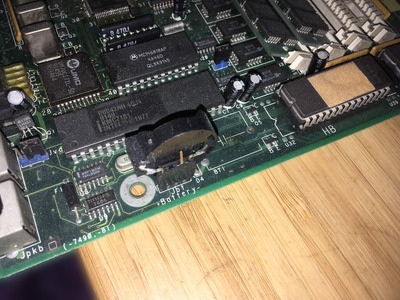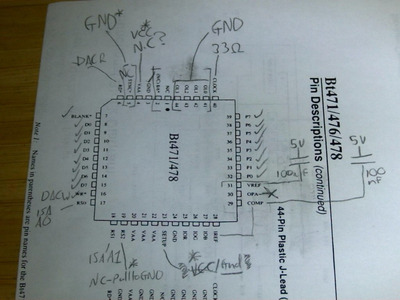First post, by Thermalwrong
I've had this Packard Bell 300 motherboard that I bought as parts a few years back. IT's a 386SX-20 in an LPX-ish form factor, with PS/2 mouse and keyboard, as well as integrated Oak OTI-037C video: https://theretroweb.com/motherboards/s/packar … 00-pb320-rev.-b
It's nice and small with PS/2 mouse so I like it alot.
It sold as 'for parts' because it's got some troubles - specifically it came with a separate video card and the integrated video didn't output. Any monitor I plugged into it would display something like "Unsupported frequency", it didn't work with a Sony CRT either so it's not my mini monitor being picky. Using my multimeter's frequency counter I checked HSYNC and it's giving 15.7KHz with 35hz on the VSYNC.
I know this is a basic and slow card, but I like to make things working and I think this video card is a good fit for a 386SX 20MHz with no cache.
According to this thread on vcfed it's because the RAMDAC has an issue: https://forum.vcfed.org/index.php?threads/nee … vga-card.48785/
I think that when the OTI-037C can't detect a working RAMDAC, it'll start outputting 15khz / 35hz in what I think would be an EGA video mode. I don't know much about EGA and can't display that.
The RAMDAC on this board is a UMC UM70C171L-50 which is a 50MHz PLCC-44 RAMDAC. Here you can see it along with an attempt at getting a CR2032 to co-operate with this board. Somehow the only picture I took of it in the first year I had it:
I was able to get video output if I heated the area of the board with the RAMDAC with a hairdrier and it would work for a bit with regular VGA monitors, then it would stop displaying again. If the RAMDAC wasn't hot enough, the monitor wouldn't start and if it wasn't kept hot while running, the picture would fade out in operation.
This is probably why the motherboard came with a separate video card, it probably failed back in the 90s.
Eventually, the RAMDAC just fell off:
I found that heating the UM70C171L's VCC pins with the soldering iron temporarily got things working and I have a hot air station now. So I decided the RAMDAC was toast and pulled it off, only nearly detached one pad. Look at how many of those pins don't do anything, just mechanically connecting the chip to the board, but no traces.
I had looked at replacement DAC chips a couple of times, the UM70C171L doesn't seem to be available now. At the time thought that the UM70C171L's pinout was unique. IT's not really though, it's all based off of the RAMDAC used in the PS/2 and one made by INMOS, the G171 which can be in either DIP28 or PLCC44 packaging. The part codes all kind of match up but the manufacturers changed a couple of digits. The parts can be substituted and I found that the Brooktree BT471KPJ-50 was mostly the same pinout and available cheaply.
The replacement Brooktree RAMDAC has the P0 to P7, D0 to D7, grounds and VCC in the same place, so I soldered it on. But it didn't work at all 🙁
The monitor was still getting fed 15.7khz and not displaying anything even though I could tell the PC was still starting up.
At this point I thought that perhaps one of the signal traces was damaged or there was some problem with the power supply for the RAMDAC. I pulled off lots of parts, replaced crystals and tried to figure out what the LM431 connected to the IREF pin does. That's a constant current source that the RAMDAC uses to generate / determine signal levels and it runs from 5v & -12v to generate a set current. I thought it was broken because the voltage was fluctuating around but no, that wasn't it, that circuit was all working properly so I put it all back to its original state.
I don't get RAMDACs too well, the address pins RS0 / RS1 connect to the A0 / A1 address pins of the ISA bus, while the Dx & Px pins go to the video card along with a few other control signals. The Oak OTI-037C's datasheet and pinout are available online so I could check with the RAMDAC which pin goes where and verified every connection was working.
I gave up for a bit and started wondering if the pinout really did match on the two RAMDACs, the BT471 has a few extra pins for overlays and reading through the datasheet for the Brooktree further, I started to notice that lots of those extra pins have to be pulled to ground or up to VCC, I'd left them floating. The Brooktree DAC has an extra VCC pin which I'd left unconnected since the motherboard doesn't route 5V to that pin. Probably the worst one was the extra address pin that I'd left floating, I think that should be pulled low to match the address states of the UM70C171:
Soldered it all together using some wires on top, along with some bypass capacitors that the datasheet calls for on some exposed VREF, OPA and COMP pins that the UM70C171 doesn't have:
And on first startup the video displayed without issue and has displayed properly every time since 😀 It's a usable computer again and I don't need to waste one of my few ISA video cards on this rather slow (but nice anyway) computer:
Now it works nicely with Windows and the display quality seems better than the RAMDAC it started with, no jailbars and the colours seem good.

